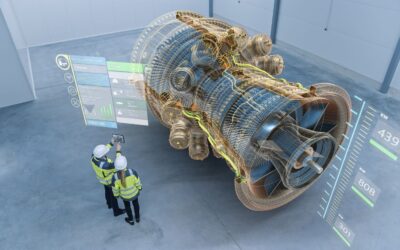Original post on tmcnet.com.
The need for high-speed network technology is now a priority for enterprises around the world, regardless of industry or vertical. Digital transformation has sparked a swift adoption of innovative devices and applications by organizations of all shapes and sizes, with the demand for fast network speeds growing alongside the number of technologies in use. Now, agile networks are essential for many business processes, but one industry in specific where high-speed networks have become critical is in the education sector.
Digital transformation is spreading quickly through education institutions, but even more so at the university level. EDUCAUSE research shows that 13 percent of colleges and universities are engaging in digital transformation today, 32 percent are developing a DX strategy, and another 38 percent of higher education institutions are exploring DX. With only 17 percent of institutions investing no time in DX, higher education truly is driving towards a digital future.
The shift is a result of the advantages a digital educational experience can offer. Between remote classes, a plethora of online learning resources, and a more personalized learning experience – not to mention the ability to leverage advanced technologies to complement more traditional teaching, technology can benefit students, teachers, and staff on a college campus.
However, to offer a true digital education, universities must be equipped with the most up-to-date network technology, given the growing importance of online and immersive learning. Because of this, universities are searching for network options that fit their unique needs, including the adoption of 5G private enterprise networks and Wi-Fi 6 and Wi-Fi 6E, to support indoors and outdoors high speed and secure broadband availability.
End-to-end Observability and AI Make Predictable, Productive Experiences Possible
“We are always striving to bring the best possible SD-WAN and Wi-Fi services to our customers and are ahead of the market when it comes to bundling innovative applications with faster and more adaptive networking,” said Steve Boalt, Director of Sales at ConnX. “There’s never been a more important or exciting time to improve the quality and availability of connectivity all the way to the very edge of the campus network than now. The pandemic greatly impacted higher ed, and opened educator’s minds to the contribution investments in faster and more secure networks make when it comes to delivering learning and collaboration experiences, in the classroom, across the campus and community including dorm rooms and off-campus housing, and to broader remote education experiences.”
Software-Defined Wide Area Networking (SD-WAN) is a transformative technology that simplifies the IT infrastructure control and management by delivering a virtual WAN architecture that securely connects users to their applications. The hallmarks of SD-WAN are simplified campus connectivity, increased reliability, optimized application performance, and increased network agility.
Furthermore, SD-WAN aggregates diverse network circuits, like broadband, DIA, and LTE (News – Alert). These circuits can be added to existing MPLS to create a hybrid network, or they can be an alternative to MPLS using all-Internet wired and wireless connections.
“Plain old SD-WAN approaches are rapidly being replaced by AI SD-WAN, given the many benefits from automation to active service assurance and smarter broadband services offers,” Boalt explained. “ConnX has been fortunate to work with Juniper Networks (News – Alert), adding our orchestration software and AI-Ops based managed services to their solutions, which are implemented in 17 of the most prestigious universities in the world today. We don’t stop at AI SD-WAN…we also leverage Juniper’s MIST Wi-Fi hardware and software offerings, to modernize always-on services supporting applications for students, faculty, staff and visitors.”
Traditional wireless LAN solutions are built on antiquated architectures that lack the scale, reliability, and agility needed to address today’s diverse enterprise needs. Juniper seeks to overcome this with its approach to wireless access that leverages AI-driven automation and insight, coupled with the agility and reliability of a microservices cloud to deliver optimized experiences and simplified network operations.
Juniper Dartmouth Case Study
“We are well over 90 percent residential, so students expect to have full access to the learning management system or classroom technologies,” says Felix Windt, director of networking at Dartmouth, which worked with Juniper to deploy a state-of-the art campus network. “They expect the network to just work, not just in the dorm but anywhere they’re meeting.”
According to the Juniper website, the Mist Platform deployment started in the Tuck School of Business and the Thayer School of Engineering, with plans to eventually roll the new Wi-Fi out to all 200 buildings on campus. Mist provides high-performance 802.11ax and 802.11ac Wi-Fi, Bluetooth LE, and IoT.
Windt developed automation tools to speed deployment. “If you shave one hour off the installation of 2000 access points, that’s the equivalent of a full-time employee for a year. That’s time we can use to serve customers instead of screwing access points into the ceilings.”
Dartmouth’s campus network uses an Ethernet VPN-Virtual Extensible LAN (EVPN-VXLAN) architecture to deliver Layer 2/ Layer 3 connectivity with greater scale and efficiency. EVPN-VXLAN decouples the underlay network (physical topology) from the overlay network (virtual topology), delivering greater flexibility. “By transforming our network from a simple Layer 2/ Layer 3 network to EVPN, we can significantly increase security zones on campus,” Windt says. “Now we can inspect east-west traffic, instead of just at the border.”
AI SD-WAN Enhance Traditional SD-WAN
AI-driven SD-WAN is an advanced, service-centric solution that takes software-defined routing to a new level. Ideal for today’s universities, it delivers a flexible, application-aware network fabric that meets stringent enterprise speed, performance, security, and availability requirements. With 92 percent of enterprises currently having a multi-cloud strategy and 80 percent having a hybrid cloud strategy, AI-SD-WAN solutions are expected to become more commonplace.
AI SD-WAN Integrated With Wi-Fi Work Harmoniously
“At the university level, the advantages provided by AI SD-WAN solutions can truly be the difference maker for some students when it comes to the education they’re getting,” Boalt said. “For example, AI-driven SD-WAN solutions improve bandwidth management, allowing campus network administrators to implement network policy with ease across a complex, segmented network environment. Network administrators also gain enhanced insight into what’s using their bandwidth, which helps them make informed decisions about policy and network architecture.”
Boalt said AI-SD-WAN solutions can also help universities with the issue of cybersecurity, which has become very prominent with cyber attackers growing in speed, sophistication, and volume in the digital age.
“By maintaining a simplified, IP broadband network of physical locations with an AI-SD-WAN tool, IT teams for individual schools and their overarching systems have a much easier job keeping everyone connected,” Boalt said. “The economics also improve, as schools save money compared to standard methods of connecting distributed locations, especially as more and more goes wireless and even faster with 5G speeds and the low-latency required for the latest in learning, including Virtual and Augmented Reality and immersive learning experiences.”
Individual schools with smaller student bases could use the technology to move away from costly high-end data solutions, allowing them to maintain the cloud-based services their students and staff rely on while drastically cutting costs, which is usually the bottom line for any organizations in today’s world, Boalt explained.
Part of Higher Ed Institutions’ Differentiation
“Bandwidth (News – Alert) and related problems like congestion can inflict serious problems upon a higher-ed institution, its employees, and its students,” Boalt said. “Now that more people are coming back to school, AI SD-WAN orchestrated in concert with more powerful WiFi (News – Alert) and edge computing solutions optimize the very kinds of traffic students tend to generate. Having grown up with fast networks at home, powerful mobile devices, and expectations from being able to attend classes virtually without any dropped sessions, jitter, or poor-quality video collaboration, to being able to binge-watch their favorite movies and shows when they aren’t studying is now table stakes for higher ed. The education industry is highly competitive, and one of the most important services students who are choosing where they will go to school is fast connectivity without fail.”
Higher ed leaders need to take the approach that up is not the same as good on your network anymore and user experience is the new uptime. This line of thinking will help differentiate higher-ed institutions well into the future.
ConnX and Juniper are co-hosting a webinar on the benefits of AI SD-WAN and AI Wi-Fi on August 3. You can register for the webinar here.









